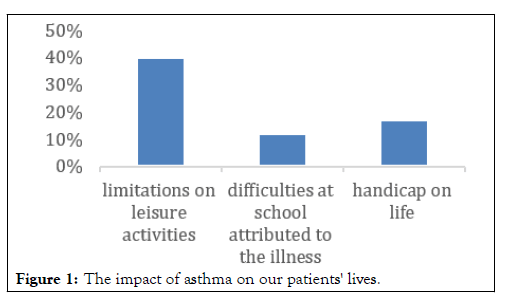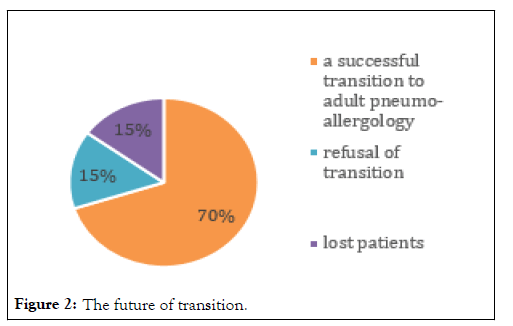Clinical Pediatrics: Open Access
Open Access
ISSN: 2572-0775
ISSN: 2572-0775
Research Article - (2023)Volume 8, Issue 6
Introduction: Medical transition is the intentional and methodically planned transition of adolescents and young adults with chronic health problems into adult healthcare systems. It is a key process aimed at ensuring continuity of medical care and guaranteeing patients' specific needs during their transition to adult consultation.
Objective: The aim of the study is to ensure the successful transition of asthma patients to adult healthcare, in order to overcome the difficulties encountered at the paediatric consultation level.
Patients and methods: This is a retrospective study of 49 patients undergoing consultation for asthma and having benefited from a transition programme in the paediatric pneumo-allergology consultation at the Abderrahim Harrouchi Mother and Child Hospital in Casablanca.
Results: The study included 49 cases, the mean age was 15 years, clinical data revealed that 20% of patients had wellcontrolled asthma, 45% were partially controlled and 35% had uncontrolled asthma. Asthma was considered a hindrance to leisure activities for 40% of patients, while 12% mentioned disturbances in their studies and 17% considered asthma a handicap. With regard to transition, 85% of patients were referred to the adult pulmonaryallergy consultation to continue follow-up with a successful transition to adult care, 8% refused the transition and 7% were lost to follow-up.
Conclusion: This study highlights the importance of transition in the care of asthma patients. Effective coordination of the transition is crucial to ensure optimal care in adult hood.
Asthma; Pediatrics; Allergy
Adolescence represents a crucial phase in individual development, during which elements such as identity, social orientation and career prospects are shaped. For sick adolescents, this period takes on special significance. They must learn to gradually acquire greater autonomy and to take responsibility for their own health and treatment. This aspect of care, which forms part of overall management, requires precise planning and support from the medical team.
It is during this prolonged transition that the adolescent evolves towards an adult health care system, a process defined as an intentional and planned movement of adolescents and young adults with physical disabilities or chronic illnesses from a childcentered to an adult health care system [1].
The transfer of adolescents with chronic diseases from pediatric to adult care must be a carefully planned and executed educational and therapeutic process; a poorly managed transition can lead to an increased risk of loss of patient follow-up, as well as multiple complications [2].
This study is based on a retrospective approach, involving 49 adolescent patients treated for asthma at the Abderrahim Harrouchi Mother and Child Hospital in Casablanca. Data were collected by means of an evaluation form, enabling us to gather information on clinical assessments of asthma and the progress of the transition process.
Among the 49 patients included in the study, the mean age at transition was 15 years, with a sex ratio of 1 with regard to asthma severity, 58% of patients were being followed for a moderate form of the disease, while 10% had a severe form and 32% a mild form. Assessment of asthma control at the time of the study revealed that 20% of patients had well-controlled asthma, 48% had partially-controlled asthma and 32% had uncontrolled asthma.
At the time of our study, 68% of our patients were receiving regular treatment with inhaled corticosteroids combined with long-acting beta-2 mimetic bronchodilators, while 2% of our patients had poor compliance with treatment.
Apart from poor compliance with treatment, other risk factors were also identified: Exposure to tobacco smoke at home was reported by 6 patients, while 5 of them had pets and 15 patients exercised regularly.
During the transition, a disturbance in patient’s quality of life was identified. Limitations in leisure activities were observed in 40%, while 12% experienced school difficulties attributed to the disease. In addition, 17% reported that asthma had a disabling impact on their lives (Figure 1).

Figure 1: The impact of asthma on our patients' lives.
It is important to note that a significant percentage of patients and their parents, 90%, were unaware of the need to transition from pediatric to adult health care. Moreover, 87% of adolescents expressed fear and panic at the announcement of the transition.
As for the outcome of the transition, 70% of patients were indeed transferred to the adult pulmonary-allergy consultation, demonstrating a significant success rate. However, 15% of patients refused the transition, while a further 15% were unfortunately lost to follow-up, highlighting the challenges faced by healthcare in managing this transition process (Figure 2).

Figure 2: The future of transition.
Asthma remains the most common chronic disease in children and publications reporting a structured consensus transition to adult care are rare. As a result, this transition remains a challenge for pediatricians.
Transfer to adult care is closely linked to a number of factors, all of which must be taken into account before this step is taken; mental and physical development, disease activity, compliance with treatment, autonomy in managing the disease and the family's socio-economic situation. All these factors must be carefully considered before embarking on this transition.
Obstacles to a successful transition can also come from the adolescents themselves. For young people, the transition can be a bad experience, leading the patient to abandon the paediatric service that has served them very well for a long time and to confront a new team of unknown caregivers.
Adult services themselves are often barriers to a successful transition. Adult doctors may not be interested in "pediatric" diseases. And generally, when faced with new patients, adult doctors may be tempted to embark on in-depth investigations and reassessments of management soon after the first consultation. This can be very destabilizing for the young person and his or her parents [3].
Hospitals' structural problems can be just as significant an obstacle to transition. Few hospitals, even within the University Hospital have well-established and reliable means of communication for transferring medical records and imaging results.
According to the recommendations, this transition must be structured and multidisciplinary and must include the pediatrician, the adult pulmonary allergist, the therapeutic education team and all those involved in medical follow-up. There is no ideal age at which to begin the transition, but it is currently recommended to start the process early, between the ages of 11 and 13 [4].
For a transfer to be successful, it is essential that adolescents have knowledge of their asthma, possible complications, treatment dosage and side effects and strategies for managing attacks. Several studies have shown that adolescents are more likely to follow treatment plans and attend medical appointments in adult services when they have a good knowledge of their pathology [5,6].
The transition to adult care requires meticulous planning. To facilitate this transition, the two teams (pediatric and adult) must collaborate by organizing joint consultations and the transfer must be anticipated, discussed with the patient and family well in advance of the desired date. It is advisable to schedule this consultation preferably during school vacations, to minimize disruption to the patient's schooling and at a time when the disease is stable. In addition, it is important to maintain continuity of treatment and action plan during this first consultation, so as not to disturb the young patient and his family unnecessarily.
A brutal transfer, particularly when precipitated by asthma attacks or the inability of pediatric services to cope with compliance problems, may well be interpreted by young people as punishment and rejection by their former caregivers. What's more, during the transition period, neither paediatric nor adult services can feel responsible for patients, leading to misunderstandings, conflicts and the onset of disease complications. If a period of vagueness occurs, the young patient may take the opportunity to withdraw from both systems.
In a prospective Swedish study that followed 150 adolescents with asthma for 5 years during the transition period from paediatric to adult management, the risk factors for deterioration were female gender, difficulties in adhering to disease-modifying therapy and lack of regular physical activity [7].
In another study involving 251 adolescents with persistent asthma, the authors concluded that 35% of them could be considered ready for this transition on the basis of responses to a specific questionnaire a value that is higher in our context but may be biased by the small number of our patients [8].
Bergstrom et al. studied 150 asthmatic adolescents during the transition process to identify the evolution of the disease during this period, they found that it was rare for lung function to deteriorate during and up to 5 years after transition in another study it was shown that 9 out of 16 patients with FEV1 ≤ 80%on showed improvement to a value >80% during the first two years after transfer to adult care [9,10].
A poor transition can have numerous side effects, as reported in our study where 15% of patients were lost to follow-up, a result similar to the study carried out by Courriel in 2003.
The transition of adolescent asthma patients from pediatric to adult care represents a complex process that is of paramount importance in the management of this chronic disease.
It is imperative to highlight hat this transition must be highly individualized, taking into account not only the specific needs of each adolescent, but also the particularities of each care facility, including its mode of operation and local characteristics. For this process to run smoothly, close coordination between paediatricians and adult respiratory allergists is essential. What's more, a thorough education of adolescents is essential, to prepare them for a therapeutic autonomy adapted to their personal situation.
[Google scholar] [PubMed]
[Crossref] [Google scholar] [PubMed]
[Crossref] [Google scholar] [PubMed]
[Crossref] [Google scholar] [PubMed]
[Crossref] [Google scholar] [PubMed]
[Crossref] [Google scholar] [PubMed]
[Crossref] [Google scholar] [PubMed]
[Crossref] [Google scholar] [PubMed]
Citation: Salimi S, Merroum I, El Marzouki N, El Bouhouj I, Alaoui IFZ, Slaoui B (2023) Transition in Adolescent Asthma Still a Challenge in Pediatric Consultations. Clin pediatr. 08:251.
Received: 18-Oct-2023, Manuscript No. CPOA-23-28003; Editor assigned: 23-Oct-2023, Pre QC No. CPOA-23-28003 (PQ); Reviewed: 06-Nov-2023, QC No. CPOA-23-28003; Revised: 13-Nov-2023, Manuscript No. CPOA-23-28003 (R); Published: 20-Nov-2023 , DOI: 10.35248/2572-0775.23.08.251
Copyright: © 2023 Salimi S , et al. This is an open-access article distributed under the terms of the Creative Commons Attribution License, which permits unrestricted use, distribution and reproduction in any medium, provided the original author and source are credited.